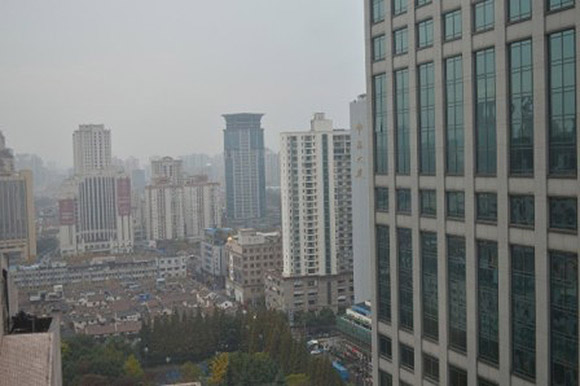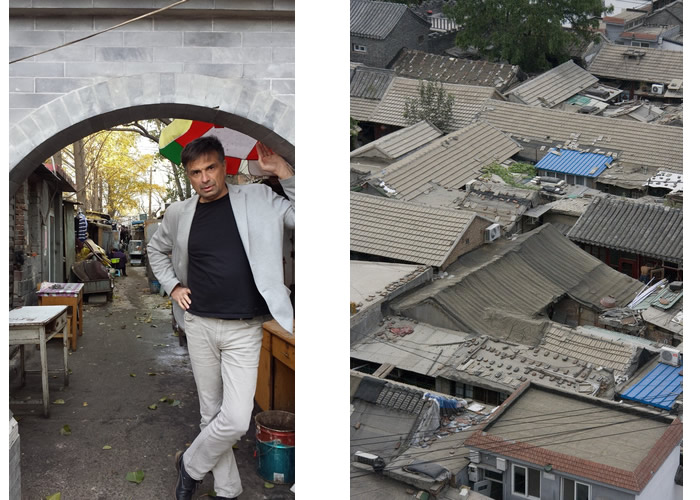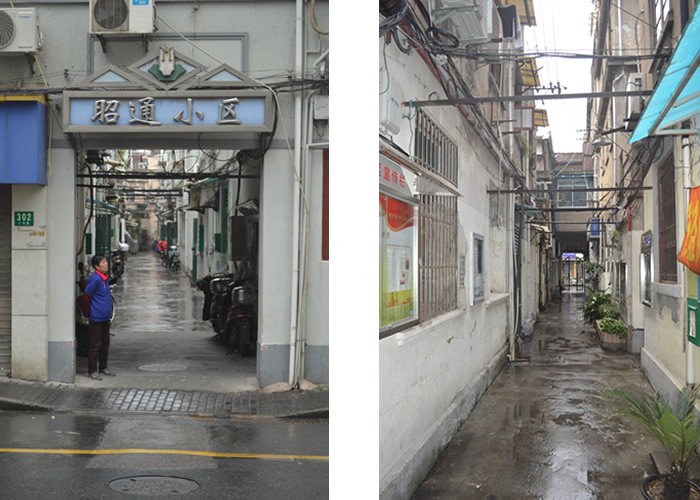Traditional Residential Areas in Beijing and Shanghai
It is always the same – buildings designed for the social elite draw the most attention. In China, these are the grand palaces and temples built for the political, ideological, and economic elite of this vast country. In Beijing, the traditional seat of political power, the most prominent structures are those of the imperial family and their communist successors. In Shanghai, the centre of economic influence, it is the villas, clubs, and hotels of domestic and foreign capitalists that command interest. All these buildings spark the imagination with visions of an exciting life infused with luxury and the allure of oriental glamour.
Yet, let’s not be deceived – the real lives of ordinary people tell a very different story. To catch a glimpse of their world, let us turn our attention to the traditional residential quarters of everyday Chinese citizens in the two largest and most significant cities of China. These quarters are steadily vanishing under the relentless tide of China’s economic expansion, raising the question of whether anything of their authentic character will survive at all.
In Beijing, such traditional residential areas are known as hutong, while in Shanghai, the terms lilong and longtang are used interchangeably. At their core, both hutong and lilong are rectangular districts enclosed by four main streets, typically measuring 200–300 metres in length and width. Access is usually limited to two or three gated entrances, beyond which a network of narrow passageways leads to individual homes.

Despite their fundamental similarities, the differences between Beijing’s hutong and Shanghai’s lilong are considerable – primarily due to the distinct histories and urban structures of these two cities.
Beijing (Bei Jing = “northern capital”) is an ancient, traditional city, the seat of absolute imperial authority, far from the sea, where inhabitants had little to no chance of ever laying eyes on a foreigner. Here, imperial rule seemed eternal, firmly rooted in the celestial principles of Taoism. In such an environment, hutongs took shape centuries ago, embodying the age-old, “eternal” tenets of Chinese philosophy and the time-honoured rural building traditions upon which they were built.
Shanghai (shang hai – “on the sea”) is a modern, cosmopolitan, and liberal city that experienced rapid growth in the 19th and 20th centuries, during the era of European settler dominance. It was in this period that lilong – a popular housing typology – emerged spontaneously, eventually spreading across nearly the entire city. The architectural foundations of Shanghai’s earliest residential districts were initially rooted in a similar, albeit less rigid, Taoist framework, as interpreted in the villages of eastern China. However, everything soon changed under the decisive impact of a specific Western European building tradition – the construction of “terraced houses.” This style, which defined the Industrial Revolution era, emerged as the most economically viable solution at a time when European cities were experiencing an unprecedented influx of new residents.
Hutong – Beijing’s Traditional Residential Quarter
The design of Beijing’s hutong is closely linked to the principles of traditional Chinese metaphysics. For centuries, China was a closed, self-sufficient civilisation, arrogantly convinced of its superiority over the rest of the world. The city of Beijing embodied the perfect earthly order that was believed to govern the heavens. At its very heart, mirroring the celestial North Star, lay the imperial palace – the Forbidden City – whose internal structure was conceived as a terrestrial reflection of heavenly perfection. The Forbidden City itself is rectangular, with its sides perfectly aligned along the north-south and east-west axes. This orientation dictated the layout of Beijing’s streets, which have persisted in this grid to the present day, despite all subsequent social and architectural transformations.
As newcomers arrived in the city, they built their family estates side by side, following the traditional model that had been established for centuries in the villages of northern China, from which they originated. Through the systematic clustering of these estates in the spaces between the city’s main streets, the hutong emerged.
A traditional rural estate, known as a siheyuan, is itself a reflection of ancient Chinese metaphysics. It consists of an inner courtyard surrounded on all four sides by houses, each with a strictly designated function. Interestingly, the houses of ordinary citizens – even those of high-ranking officials living near the Forbidden City – were almost identical. They were always single-storey structures with traditional concave roofs and exclusively grey in colour, as vibrant hues (such as red, gold, and blue) were reserved solely for the buildings of the imperial family.
The organisation of space followed the principles of feng shui, i.e., the principles governing the mystical flow of life energy, resulting in a curious blend of rationality and superstition. Today, in the West, feng shui is often regarded as a charming, harmless trend, and we are pleased when we notice its occasional similarities to our own rational architectural solutions. It becomes less charming, however, when we consider that our counterparts—ancient Chinese builders—were born, lived, and died in a world governed by “good” and “bad” spirits, without ever questioning which of these beliefs had any real, tangible significance.
The entrance to a siheyuan courtyard was always positioned to welcome the flow of “good energy,” while special standalone partition walls were built solely to block “evil energy,” serving no other purpose. Yet, in a strikingly practical approach, the main house of a siheyuan was invariably placed on the northern side, facing south for optimal sunlight. When multiple siheyuan were built next to one another, they formed the traditional Beijing residential district known as a hutong. This meticulous alignment fit perfectly into the planned construction of the imperial capital, where everything was oriented along the precise axes of north, south, east, or west. The development of modern Beijing and its hutongs began as early as the 13th century, during the reign of the Mongol emperor Kublai Khan, who valued and supported traditional Chinese culture. In this context, it is worth noting that both siheyuan and hutong are words of Mongolian origin, despite their deep-rooted connection to Chinese tradition.
As long as imperial rule remained firm and belief in cosmic order unshaken, the structure of hutongs also held strong. However, as the authority of the emperors began to waver, so too did the strict order of its subjects’ residential quarters. Properties were divided and reoriented, complicating courtyard access and disrupting the flow of movement within neighbourhoods. With the fall of the empire, their tradition started to decline, and hutongs gradually descended into chaos. In recent decades, they have been rapidly demolished to make way for wide boulevards and high-rise buildings, erasing a once-defining element of Beijing’s urban landscape.

The remaining hutongs in Beijing are now enclosed by walls, hidden from view and difficult to access. Even if one manages to find them, entering is virtually off-limits to foreigners and, in any case, deeply uncomfortable – one feels like an unwelcome guest intruding into the intimate space of the city’s poorest residents. Allegedly, within these impoverished hutongs, a strong smell of urine lingers in the air.
Beijing’s municipal authorities have expressed their intention to preserve some of the traditional hutongs from demolition, but how they plan to achieve this remains to be seen.
Lilong – The Residential Quarter of Shanghai
The development of modern Shanghai began in 1842 when Chinese authorities were forced to allow foreigners to settle and conduct business within the so-called “Concessions” – designated zones governed by separate legal system. This ushered in an era of rapid economic success, which peaked between the two world wars. Although it was not originally planned this way, restrictions on Chinese settlement in the Concessions were soon lifted, and migration into the city surged. The influx of people was so massive that Shanghai became one of the largest – if not the largest – cities in the world at the time. The demand for housing skyrocketed, and local builders had to devise an effective solution for integrating these newcomers from the surrounding rural provinces – people who brought with them their own ways of life – into a city ruled by foreigners.
The initial idea was, naturally, to construct houses in the same traditional style as those found in the surrounding villages. Unlike the rural homes near Beijing, those in this part of China were far less influenced by feng shui and Taoist traditions, as they were situated far from the centre of political and religious power. These were single-storey wooden houses built for extended families, broad in frontage, with five windows facing the main street as a standard feature. However, the influence of foreigners and Shanghai’s rapid social evolution fundamentally altered this tradition. Families grew smaller, houses became two-storey but narrower, with only two windows facing the street, and the use of wood was strictly prohibited by foreign authorities due to fire hazards.
Thus, in the second half of the 19th century, the traditional Shanghai house – known as shikumen –emerged, eventually dominating nearly the entire city in the decades that followed. The shikumen proved exceptionally well-suited to the development of “terraced housing”, a concept directly borrowed from the Industrial Revolution era when European cities faced similar challenges due to mass urban migration. The term shikumen, which refers to the traditional Shanghai terraced house, literally means “stone gate”, and originally described the shared stone wall that lined entire rows of houses, each with its own entrance.
A lilong (li=community, long=alley) is a residential quarter composed of interconnected alleyways, where individual shikumen are arranged in rows. Some of these alleyways open onto public city streets, typically marked by a decorative arch and a gate that is locked at night.
Unlike Beijing’s hutong, now almost inaccessible, the lilong alleyways are semi-public spaces, generally open to access and with far less sense of discomfort when entering. These narrow passages are crisscrossed with steel drying rods for laundry, tangled with a web of overhead electrical cables and other wiring, and serve as spaces for parking bicycles and motorbikes, plucking chickens, and chopping vegetables – all within their narrow two- or three-metre width. For those who grow up in shikumen, the experience is unforgettable, and life in these houses has become an inseparable part of the nostalgic, old Shanghai romanticism.
During their golden age, the sprawling network of Shanghai’s lilong alleyways provided an ideal setting for a range of illicit and semi-legal activities. Gambling, opium trafficking, and prostitution thrived here, while in the more elegant shikumen, Western guests were entertained by sing-song girls – Shanghai’s equivalent of Japanese geishas. These women became so popular among foreigners that the municipal budget of the international concessions even included an official fixed allocation for the upkeep of sing-song establishments. The Shanghai police showed little interest in venturing into the lilong labyrinth to crack down on illegal activities – after all, these were not seen as a threat to the city’s life but rather as part of its allure.
Yet, one particular subversive activity that took root within the lilong would ultimately spell the downfall of both the Chinese authorities and the foreign concessions, forever altering the course of the nation. It was in the hidden, impenetrable depths of Shanghai’s lilong that the Chinese Communist Party held its first congresses. And so, amid the revelry of sing-song girls and an atmosphere thick with both revolutionary fervour and opium fumes, the Communist movement took its first tentative steps on its triumphant path to absolute dominance.

Although old lilong are being demolished in today’s Shanghai to make way for modern skyscrapers, a significant number still remain, and for now, their survival does not seem to be under immediate threat. Life within them retains much of the same romantic charm it had a century ago, and it appears that the people of Shanghai deeply appreciate this heritage.
Darko Veselinović, July 2015



